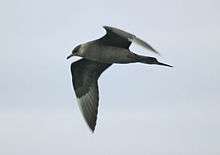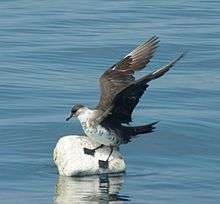Parasitic jaeger
| Parasitic jaeger | |
|---|---|
 | |
| Scientific classification | |
| Kingdom: | Animalia |
| Phylum: | Chordata |
| Class: | Aves |
| Order: | Charadriiformes |
| Family: | Stercorariidae |
| Genus: | Stercorarius |
| Species: | S. parasiticus |
| Binomial name | |
| Stercorarius parasiticus (Linnaeus, 1758) | |
The parasitic jaeger (Stercorarius parasiticus), also known as the Arctic skua or parasitic skua, is a seabird in the skua family Stercorariidae. The word "jaeger" is derived from the German word Jäger, meaning "hunter".[2] The English "skua" comes from the Faroese name skúgvur [ˈskɪkvʊər] for the great skua, with the island of Skúvoy known for its colony of that bird. The general Faroese term for skuas is kjógvi [ˈtʃɛkvə].[3] The genus name Stercorarius is Latin and means "of dung"; the food disgorged by other birds when pursued by skuas was once thought to be excrement. The specific parasiticus is from Latin and means "parasitic".[4]
Breeding
This species breeds in the north of Eurasia and North America, with significant populations as far south as northern Scotland. It nests on dry tundra, higher fells and islands, laying up to four olive-brown eggs. It is usually silent except for mewing and wailing notes while on the breeding grounds. Like other skuas, it will fly at the head of a human or fox approaching its nest. Although it cannot inflict serious damage, it is a frightening and painful experience. It is a migrant, wintering at sea in the tropics and southern oceans.
In the British Isles, they breed in Shetland and Orkney, the Outer Hebrides, Sutherland, Caithness, and some islands in Argyll.
Feeding
This bird will feed on rodents, small birds and insects. It also robs gulls and terns of their catches.
Description

Identification is complicated by similarities to long-tailed jaeger and pomarine skua, and the existence of three colour morphs. Small for a skua, the parasitic jaeger measures 41–48 cm (16–19 in) in length, 107–125 cm (42–49 in) in wingspan and weighs 300–650 g (0.66–1.43 lb).[5][6] The tail streamer of the breeding adult accounts for about 7 cm (2.8 in) of their length. Light-morph adults have a brown back, mainly white underparts and dark primary wing feathers with a white "flash". The head and neck are yellowish-white with a black cap and there is a pointed central tail projection. Dark-morph adults are dark brown, and intermediate-phase birds are dark with somewhat paler underparts, head and neck. All morphs have the white wing flash.

Identification of juveniles is even more problematic, and it is difficult to separate parasitic jaegers from long-tailed jaegers. Parasitic jaegers are bulkier, shorter-winged, and less tern-like than long-tailed jaegers. They are usually warmer toned, with browner shades, rather than grey. However, they show the same wide range of plumage variation. The flight is more falcon-like.
The typical call of these birds is a nasal mewing sound, repeated a few times in display. Their alarm call is a shorter sound.
References
- ↑ BirdLife International (2012). "Stercorarius parasiticus". IUCN Red List of Threatened Species. Version 2013.2. International Union for Conservation of Nature. Retrieved 26 November 2013.
- ↑ "Jaeger". Oxford English Dictionary (3rd ed.). Oxford University Press. September 2005. (Subscription or UK public library membership required.)
- ↑ "Skua". Oxford English Dictionary (3rd ed.). Oxford University Press. September 2005. (Subscription or UK public library membership required.)
- ↑ Jobling, James A (2010). The Helm Dictionary of Scientific Bird Names. London: Christopher Helm. pp. 292, 365. ISBN 978-1-4081-2501-4.
- ↑ "Parasitic jaeger". 2011.
- ↑ Dunning, John B. Jr., ed. (1992). CRC Handbook of Avian Body Masses. CRC Press. ISBN 978-0-8493-4258-5.
External links
| Wikimedia Commons has media related to Stercorarius parasiticus. |
| Wikispecies has information related to: Stercorarius parasiticus |
- Arctic skua - Species text in The Atlas of Southern African Birds
- Arctic skua information and photos at the Handa Island Skua Project
- RSPB Birds by Name: Arctic skua
- "Arctic skua media". Internet Bird Collection.
- Parasitic jaeger photo gallery at VIREO (Drexel University)
- Interactive range map of Stercorarius parasiticus at IUCN Red List maps
- Audio recordings of Parasitic jaeger on Xeno-canto.
